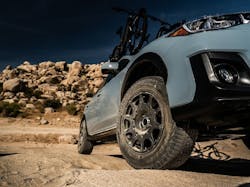As if CUVs weren’t already taking American roadways by storm, these versatile nonsedans are now increasingly the vehicle of choice for those who want to play off-road, too.
So while enthusiasts install lift kits on their Subaru wagons and debate on Instagram what tires are the gold standard for CUVs — yes, this is happening — automakers haven taken notice. Some already offer “sport” and “wilderness” trim packages and tiremakers indicate there are many more coming to the market.
It begs the question, “Are off-roading CUVs about to create a new tire segment?” So far, there’s not a universal answer.
Steven Liu, senior director proprietary brands for Hercules, which is owned by American Tire Distributors Inc., says the long-term popularity of CUVs “is pushing tiremakers to create more options for CUV sizes across the tire application spectrum.
“This could mean a new tire segment may be emerging and that has potential to reshape the landscape.”
Stephen Leu, director of the brand publishing department at Nitto Tire U.S.A. Inc., says, “We believe that it is an irrefutable fact that this is a growing sub-segment within the CUV market. What was once only known to the niche/enthusiast market has now gone mainstream.”
Drew Howlett, product manager for Sumitomo Rubber North America Inc.’s Falken brand lineup of light truck, SUV and CUV tires, says tiremakers will have to be careful to match tires to the capabilities of these off-roading vehicles. He’s not sure if the whole industry will do that.
“It would be interesting to see other tire manufacturers offer lightweight R/T or M/T-category tires for the more extreme off-road crossover owner, but it’s possible this segment is too niche for manufacturers to make the investment at this time.”
Others see automakers simply following trends established in the aftermarket.
Todd Bergeson, senior product manager of light truck tires for Toyo Tire U.S.A. Corp., says his company “began making specific CUV off-road tires long before vehicle manufacturers began to apply all-terrain tires as an OE option or special edition package.”
While Toyo and other companies say they’ll make tires for this segment a “priority,” we asked tire manufacturers to explain the challenges these fitments present — and what dealers need to know as things move forward.
MTD: What are the demands and challenges in creating tires for off-roading CUVs?
Michael Mathis, president, Atturo Tire Corp.: The primary challenge is maintaining the balance between tough construction and lighter weight. While these vehicles have some legitimate off-road capability, they do not have the axles or powertrains to support turning heavy LT-rated tires. Atturo has conquered this challenge with two different tire models built in sizes specifically designed for off-roading of CUVs — the Trail Blade ATS and Trail Blade X/T.
Iris Ocasio, product planner for the Bridgestone Americas Tire and Solutions Group, Bridgestone Americas Inc.: CUVs frequently serve a dual purpose. Customers want a tire that not only delivers off-road capabilities, but also on-road performance. Success in the CUV segment comes with balancing off-road performance and on-road characteristics drivers have come to expect, such as wear performance, ride comfort, wet traction and noise.
Barry Terzaken, light truck and SUV tire product manager, Continental Tire the Americas LLC: For many off-roading CUV drivers, their vehicle is also used as a daily driver. This broad spectrum of performance requires a tire that delivers a quiet and comfortable ride (and) good on-road traction, balanced with the off-road capability needed for the trails. Delivering this balance of performance at a high level involves not only the proper choice in compounds and materials, but careful attention to tread pattern design.
Michiel Kramer, executive director of product marketing, Cooper Tire & Rubber Co.: For the Cooper brand, we work to cater to consumer needs in all segments — but certainly in the CUV segment — within our product portfolio. We have identified all-weather (3-Peak Mountain Snowflake) and off-road capability as critical performance needs for the all-terrain segment and have catered to it with our Cooper Discoverer AT3 4S.
David Shelton, director of industry relations, Giti Tire (USA) Ltd.: Just picture a CUV and add a fire extinguisher hanging on the side, which has the roll-out sunshade attached to that side of the oversized luggage rack. Also the vehicle may have a high lift jack or a Jerry Can hanging off the rear like you would see on a well-equipped, off-road prepared Jeep. It also could have a few extra lights mounted around the rack. And, of course, it has all-terrain tires. None of these were considered for the CUV more than a couple of years ago. As urbanites long to escape the city, they found the need or the desire to take the vehicle they purchased for the city and make it a true crossover utility vehicle.
Moonki Cho, product manager, Hankook Tire America Corp.: As off-road tires are normally engineered to perform on various rugged terrains for pickup trucks and off-roading vehicles, they are typically designed with more aggressive tread patterns that lead to added noise, vibration and reduced fuel efficiency on-road. Additionally, off-road CUV tires have become somewhat of a lifestyle category, where some consumers are seeking the ‘look,’ whereas others are seeking performance. The biggest challenge is to create tires that are well-balanced between the consumers’ different needs.
Steven Liu, senior director proprietary brands, Hercules: The demand for tires for off-roading CUVs continues to grow as automakers are offering specific trim level/models with vehicle design specs that allow the vehicles to go off-roading, and in these cases, the vehicles come with original equipment all-terrain tires. The challenge is when the market comes to a ramp-up point. What are all the options available? Will the market be in all-terrain, R/T or a possible new hybrid between A/T and H/T? The counter salesperson at the retail end is expected to be trained and understand the products fully, both cars and tires, in order to give the proper recommendations. Similar to all-wheel drive and winter tires, knowing the CUV is capable of off-roading is the start. Knowing what the user intends to do with the vehicle is the key.
Brandon Stotsenburg, vice president of the automotive division, American Kenda Rubber Co. Ltd.: Kenda considers CUV vehicles to be SUV bodies on automotive platforms while SUV vehicles are on light truck platforms. This fundamental difference in the vehicle platforms often requires different tire design, compounding and construction to achieve the best, consistent performance for the respective vehicles. Differences in the platforms vary, but will often include weight and suspension designs, which often affect vehicle handling, ride, noise and tire wear. As Kenda has focused its new products to provide premium performance at a value price, we have three primary products that best match the vehicle platform performance criteria within our Klever family — one primarily for CUVs, one for SUVs and a third for CUV and SUV applications that require an all-terrain platform, the Klever A/T2 KR628.
Brandon Sturgis, BFGoodrich global product manager for light truck tires, Michelin North America Inc.: Our main focus in creating a tire for off-roading CUVs is finding the right balance of on-road versus off-road performance. Off-foad-oriented CUVs have great features to help with off-road performance, but it’s clear they are not designed for aggressive trails. Occasional driving on gravel roads, light mud capabilities and snow traction are key off-road elements that our consumers view as the most important. They also told us their off-road-oriented CUVs will still spend a majority of their time on road, so it’s still important to consider noise, comfort and fuel economy in the design.
Jay Lee, product planning director, Nexen Tire America Inc.: Our priorities are to ensure durability and style. Even though all-terrain tires are designed for on- and off-road conditions, CUV customers do not tend to go to mountainous areas as much. With that, low noise and comfort are also priorities for Nexen.
Stephen Leu, director of the brand publishing department, Nitto Tire U.S.A. Inc.: The challenge lies in creating a product that provides robust o -road performance, while delivering the ride comfort and low noise that CUV owners come to expect.
Michael Gerowitz, head of product, Pirelli Tire North America Inc.: The tires are key contributors to performance, on- or off-road, for the increasingly off-road-capable CUVs. When it comes to creating tires for o -road-capable CUVs, the main challenges are clearly o -road performance and overall design. Pirelli develops tires that have satisfying handling and feel, combined with the automakers’ original targets for original equipment. In replacement tires, we combine our OE insights with specific targets to help achieve more miles in service. On the design of a tire, the look of the tire to the vehicle goes into our product development process. The tire has to perform and it has to have the right look to match the vehicle.
Nick Gutierrez, sales director, Sentury Tire USA: Demand continues to grow as more and more of the secondary CUV market becomes available not only in the new, but (the) used side, too. I don’t see it throttling down. I have long-standing relationships with wheel companies and they continue to develop more options for CUV off-roading. One main challenge will be applications. It hasn’t been nor will it ever be one-size-fits-all. So developing a strong range will come with time and feedback from our consumers.
Drew Howlett, product manager for Falken light truck, SUV and CUV tires, Sumitomo Rubber North America Inc. (SRNA): The challenge of creating an off-road tire for CUVs is found in minimizing the trade-offs. Folks who purchased a crossover want the positive features of a car — fuel efficiency and sporty handling — and the benefits of a truck — cargo space and capability — minus the drawbacks. As a tire manufacturer, we know this is a delicate balancing act. Increase off-road traction and you risk adding noise inside the cabin. Build a heavier, more durable tire and you decrease fuel efficiency. It’s a difficult undertaking to say the least.
Falken has found the best way to combat this is to know as much about the end consumer as possible. When developing the WildPeak A/T Trail, we spoke with over 5,800 crossover owners across the United States and Canada to gain a clear understanding of the marketplace. Our findings indicated that a well-defined subset of crossover owners use their vehicles for both daily driving and outdoor adventuring, just like many 4x4 SUV and pickup owners do.
Rick Wheeler, vice president of national sales, Tire Group International (TGI): The rapidly growing crossover utility vehicle segment presents unique challenges for today’s tire manufacturers. Tires are being placed on vehicles that look like small SUVs, but are built mostly on car platforms. Tires on CUVs need to look the part of an SUV — aggressive, tough, able to go off road (and) perform in other than highway conditions. But at the same time, they need to deliver great highway performance — a smooth, quiet ride that wears well and delivers high value for the owner. A great CUV tire bridges the gap between a traditional all-season radial tire and an all-terrain tire that looks aggressive enough to go off the beaten path, but still offers that great highway performance, which is where most of the driving is actually done.
Todd Bergeson, senior product manager of light truck tires, Toyo Tire U.S.A. Corp.: There are many challenges to developing off-road tires for CUVs. Our new Open Country A/T III was in development for several years, as it was our intention to achieve snow traction at a level that would achieve the 3-Peak Mountain Snowflake mark. Through our research, CUV owners are likely to use their vehicles in the mountains and/or in states where snow traction is important. Additionally, tire weight and pattern noise are crucial for CUV owners. Most CUVs do not have the sound isolation that many luxury SUVs and light trucks have, so a quiet pattern is a must. CUVs in general are attractive to buyers due to their capability and high fuel economy.
Drew Dayton, senior product planning manager for consumer tires, Yokohama Tire Corp.: The demands and challenges in creating a tire for off-roading CUVs are finding that balance between off-road performance and on-road comfort. Most CUV owners looking for some level of off-road capability still expect the vehicle to deliver on the attributes that may have led them to make the purchase in the first place. These are typically more on-road-focused benefits like urban/highway performance, low noise and a comfortable ride. Tires like the Yokohama Geolandar A/T G015 strike this balance by matching tire needs and wants with the vehicle needs and wants.
Continental’s Barry Terzaken doesn’t think off-roading CUVs need their own tire segment. But tiremakers need to offer the right sizes and speed ratings.
MTD: How does the popularity of off-road styling and marketing by automakers affect your overall approach to CUV tires? Is it just one more segment to address and cover or is it changing the baseline for CUV products?
Mathis (Atturo): The interest in small, off-roading CUVs has been growing for some time among enthusiasts around the world — well before the automakers decided to market directly to them. Jeep and Subaru were some of the first to build dedicated, off-road-capable vehicles in this segment. Atturo sees this as a natural extension of the aftermarket tire options for these vehicles. Atturo has been building tires for these applications for several years already.
Ocasio (Bridgestone): There are two main factors that play into how this segment is changing. The first is the expansion of all-terrain products into more CUV-focused sizing, which is just addressing a new part of an existing segment. The second is the general trend of creating more rugged imaging around CUVs as a whole, which can impact other segments, such as touring and highway. These trends need to be considered when designing tread patterns and sidewall styling for all segments to ensure that we are creating products that compliment these new CUVs.
We need to address CUV sizing for all-terrain patterns. Currently, all vehicles are trending toward an overall aggressive/rugged appearance. These trends need to be considered when we design new patterns for highway-type products.
Terzaken (Continental): Off-road styling and marketing of vehicles is a natural extension of traditional, larger off-road vehicles. A separate CUV tire segment is not needed, so long as styling is appropriate and the balance of on- and off-road capability is met. The key is to offer proper sizes and speed ratings for modern CUVs. With the Continental and General brands, we continually review and extend our size offerings to meet the needs of off-roading CUVs. Two key General Tire brand products are the General Grabber APT and the General Grabber A/T X . Grabber APT has a strong on-road focus, good off-road capability and 3-Peak Mountain Snowflake-rated winter performance on most articles. Grabber A/T X delivers off-road capability, coupled with on-road performance, plus it offers 3-Peak Mountain Snowflake winter performance.
Kramer (Cooper): There has been significant growth of the CUV segment in new vehicle sales over the past several years, as recent trends show consumers have chosen CUVs over traditional sedans. These trends have spurred industry sales growth for tires in the 17-inch and larger wheel diameters. Our research shows a growing interest in all-terrain tires by CUV owners. This trend is expected to grow in the years ahead.
Shelton (Giti): This shift to CUVs with all-terrain tires is a logical transition for the adventure-spirited individuals who find themselves shifting from pickups and SUVs to the more comfortable CUVs for everyday urban driving. These consumers are provisioning the vehicle for the weekend escape from urban or suburban life. Some utilize the conventional sizing in all-terrain tires, whereas some are looking for sizing that is correct for their vehicle as so many of the electronics in the vehicle are connected to rolling circumference or revs-per-mile.
Cho (Hankook): While we have seen off-road marketing in pickups and larger SUVs in the past, we are now seeing the trend continue into the smaller CUV segment, as well. Due to these changes, the aggressive style and performance previously only seen in off-road tires are now also being applied to smaller CUV tires. We believe that the CUV market will be more and more segmented, according to this trend in the future.
Liu (Hercules): Hercules recognizes the popularity of off-road styling and we want to help supply the ever-changing needs of our dealers, which will ultimately help them increase their market share. I think current demand is pushing tiremakers to create more options for CUV sizes across the tire application spectrum. The popularity of CUVs has staying power and now with more capability, these vehicles provide newer technology and vehicle dynamics. This could mean a new tire segment may be emerging and that has potential to reshape the landscape. It could also elevate the baseline of CUVs in the future, where every household has one for general purpose driving and one for fun. The CUV isn’t just the new passenger sedan with larger space. It can also be fun, sporty, high-performance and now even used for off-roading. In July, we launched a new all-terrain tire in the Terra Trac lineup that specifically addresses the CUV market.
Stotsenburg (Kenda): Kenda offers different pattern choices for the aftermarket vehicle applications, which allows the dealer and end-user to prioritize based on their specific needs and the vehicle’s capabilities. For example, we offer a 265/70R17 in H/T, A/T, R/T and M/T patterns, with several also available in both P-metric and LT. For the Toyota 4Runner TRD, which has a single body frame, the consumer can choose a product based on the amount of off-road capability needed. Consumers who purchase an off-road package — regardless of CUV, SUV, truck or Jeep — generally are doing online and experiential research. Kenda will produce products for the applications where there are reasonable volume needs that are applicable for our brand’s value proposition.
Sturgis (Michelin): It was clear a few years ago for BFGoodrich tires that the popularity of off-road-oriented CUVs was on the rise and that we needed to have a specific product for these vehicles. BFGoodrich has a history of performing in the dirt. Now it’s time for us to help CUV owners join us. We are launching our new tire for this segment in September 2021, the BFGoodrich Trail-Terrain T/A.
Lee (Nexen): The CUV segment is one of the fastest-growing in our industry. Normally, tires for CUVs are focused on handling, noise and comfort. In the case of the off-roading CUV segment, it’s still a growing and niche subdivision. It will continue to grow to meet customers’ evolving demands, but for the time being, we are meeting multiple market demands by making all-terrain tires in CUV sizes for on- and off-road conditions. This means reinforced for 3-Peak Mountain Snowflake, noise and comfort.
Leu (Nitto): We believe the styling by the automakers is simply a reaction of the trends that have already occurred in the aftermarket. Much like other vehicle segments, there are products that cater to the niche/enthusiast and others for the masses. We don’t believe this trend will reinvent the entire CUV category, but it will require tire manufacturers to have specialized products to serve the unique demands of this sub-segment.
Gerowitz (Pirelli): The DNA of full-size SUVs and sporty sedans has transcended into today’s crossover utility vehicles. Crossovers are being designed to continue where the pavement may end, requiring tailor-made tires that have a wide operating service window, from national forest trail exploring to overlanding adventures without roads, while still being quiet and comfortable for commuting and around-town trips.
Gutierrez (Sentury): The auto styling in general continues to evolve. Lifestyles are going back to grassroots and at Sentury Tire USA, we’re excited to be a part of a growing segment.
Howlett (SRNA): Most automakers have launched or are planning to launch an adventure-oriented trim level of their current crossover vehicles. They’re appealing to the outdoor enthusiast with ‘ruggedized’ styling, in addition to increased off-road functionality features, such as ground clearance, hill descent control and advanced, all-wheel drive traction control systems. Jeep’s Trailhawk trim of the Renegade and Compass, Subaru’s newly announced Wilderness trim, Toyota’s RAV4 TRD Off-Road and Ford’s new Bronco Sport have set the bar and we expect other automakers will follow suit. Off-road tires for crossovers (also) will further sub-segment in the very near future. Falken already offers both the WildPeak A/T Trail and A/T3W in many common crossover sizes — such as 225/65R17 and 245/65R17 — to provide options for customers.
Wheeler (TGI): I believe the trend of U.S. auto manufacturers moving to offerings based on light truck, SUV and CUV lines with limited car segment offerings is here to stay. Bottom line is pickups, SUVs and CUVs are much more versatile than cars. A small CUV can be economical, yet add a few high-performance options and you are left with an off-road-worthy vehicle. A Subaru is a perfect example of a small CUV that offers option packages from stock front-wheel-drive, all the way to turbocharged, all-wheel-drive that will go off-road.
Bergeson (Toyo): As is usually the case, the aftermarket leads the trends and OEMs will often follow suit. We began making specific CUV off-road tires long before vehicle manufacturers began to apply all-terrain tires as an OE option or special edition package. We love off-roading and exploring. We are thrilled with the influx of demand for SUVs and CUVs or any vehicle that affords consumers the opportunity to get out and explore the beautiful and wondrous outdoors. We will continue to support these segments with priority.
Dayton (Yokohama): Even before the popularity of off-road CUVs started to hit the market, Yokohama’s Geolandar A/T G015 size lineup included several sizes that fit popular CUV models, such as the Honda CR-V, Mazda CX-5, Subaru Forester, Subaru Outback and Toyota RAV4. This is a really balanced option for CUV owners actually looking to spend some time off-road. The Geolandar lineup also includes tires for more traditional CUV usage. So the baseline for CUVs does not change, but given the size of that vehicle category, it should come as no surprise that there are sub-segments within CUVs.
Yokohama’s Drew Dayton says recommending the right tire “comes down to how the consumer plans to use their vehicle, rather than how the automakers choose to promote them.” The Geolandar A/T G015 tire is pictured on the 2022 Subaru Outback Wilderness.
MTD: What do tire dealers need to know?
Mathis (Atturo): Tire dealers need to be willing to show consumers what the tire options are for their CUV. Ask probing questions about the driver’s interests and hobbies. If they go camping, fishing, hunting or just like to take an occasional trail ride, then one of the all-terrain or more aggressive hybrid-type tires Atturo offers could be appealing to them. This is a great upsell opportunity and creates excitement in the driver beyond a regular tire replacement.
Ocasio (Bridgestone): With the growth in this segment, dealers should be aware of size expansions in all-terrain type patterns. Dealers are encouraged to make CUV owners aware of potential trade-offs with the more aggressive, all-terrain type patterns. As a tire manufacturer, we work hard to minimize these trade-offs, but with more rugged-type tires, the customer needs to understand that some on-road performance may differ from your conventional highway tire. As always, we recommend having detailed discussions with end users about how they plan on using their vehicle and what their priorities are in terms of tire performance to ensure they purchase the right product.
Terzaken (Continental): Dealers need to talk to their customers and qualify their needs. Understanding the customer’s needs and matching those needs with the proper tire line will make the end consumer happy and make the dealer shine.
Shelton (Giti): This is a segment that has materialized over the past few years and should continue to expand. The dealer should get a good perspective on the consumer’s expectation to ensure the customer is satisfied with his or her purchase.
Cho (Hankook): The most important thing for dealers will be to understand what their customers want. As a consumer’s needs are widely varied, it will be imperative that dealers ask the right questions to understand the needs of the consumer and recommend the right product. As there are a variety of CUV tire segments, such as highway, allterrain, off-road, all-weather, etc., dealers should be aware of which type of tire their customers need to meet their driving needs and vehicle type.
Liu (Hercules): CUVs are a great alternative to sedans. There are more CUVs sold than passenger sedans, so consumers are on-board. Fuel efficiency is improving, plus ride comfort and handling is comparable, if not better, than sedans. Given the technological advancement and automakers’ demands, more functional multi-purpose and variations of CUVs are being introduced today. This is pushing tire manufacturers to upgrade and create products that meet the new design attributes, based on the vehicle dynamics of these modern vehicles.
Stotsenburg (Kenda): The CUV segment will continue to be strong, with growing 18-inch and larger diameters over-indexing moving forward. Within the U.S. and North American markets, vehicle manufacturers are betting on continuing consumer demand for CUVs, but most of these vehicles are really designed for on-road use, while some models offer features which will allow limited off-road capabilities. Generally, an A/T tire with good off-road capabilities will be sufficient to meet the CUV’s off-road design capabilities.
Sturgis (Michelin): Consumer behavior is changing. Work travel is shifting to leisure travel. Growth in outdoor recreation and do-it-yourself projects leads consumers to opt for all-wheel-drive versatility. New consumers are in the space. The car market is changing. Consumer trends are driving all-wheel-drive CUV, SUV and truck category growth. There is significant OE interest in tires that offer off-pavement capability while maintaining fuel economy.
Lee (Nexen): Off-roading CUV tires are more stylish than regular tires. They have more durable performance for on- and off-road conditions. With this ‘pro’ also comes the ‘con’ that noise and comfort are not as strong as regular tires, so before selling off-road tires to CUV owners, dealers should take note of the individual customer’s priorities.
Leu (Nitto): We believe that it is an irrefutable fact that this is a growing subsegment within the CUV market. What was once only known to the niche/enthusiast market has now gone mainstream, as evidenced by the OEMs’ offerings (i.e. Subaru Outback Wilderness, etc.). It will be important for dealers to understand the unique value propositions these specialized tires provide during the sales process as more of these off-road-styled CUVs come for their first set of replacement tires.
Gerowitz (Pirelli): We see larger wheel sizes continuing to grow in this and future generations of CUVs and consumers choosing tires that appeal to their usage needs, as well as how the tire looks on their vehicle. Dealers being up to speed on the latest tire programs will play a contributing factor in helping consumers pick the right tire for their needs.
Gutierrez (Sentury): Just like anything in business, you have to be open to what customers want. Having an open mind will grow sales today and in the future. This segment will continue to grow.
Howlett (SRNA): Moving a customer from an all-season tire to a more off-road-capable tire doesn’t necessarily require a compromise in performance. If the tire provides off-road traction, durability and winter traction, it can be a fantastic upgrade. However, retailers should be cautious of which tires they recommend for off-road-oriented crossover owners. Many all-terrain tires on the market are heavier and louder than a typical crossover all-season tire — characteristics that become much more noticeable on a crossover when compared to a pickup truck or traditional SUV with respect to reduced fuel economy and increased interior noise. There’s no one-size-fits-all recommendation for these drivers.
Wheeler (TGI): The tire dealer of today must be able to recognize the capabilities of today’s CUVs being offered from the manufacturers and be able to identify the best fitment for those vehicles. Bottom line is (that) just because the size on the sidewall is correct, it doesn’t mean any tire in the rack will do a good job and exceed customer expectations.
Bergeson (Toyo): There is a lot of opportunity within this segment and a lot of education needed to ensure vehicle modifications are done safely and in a way that will effectively improve the vehicle’s performance on- and off-road. For example, we offer a number of P/euro-metric sizes to support the unibody-constructed CUVs. It is crucial that the correct tire be used to ensure the proper load-carrying capacity and inflation pressures are used.
Dayton (Yokohama): Dealers need to know that the CUV segment continues to grow year-over-year, making up almost half the new vehicle sales in 2020. Most of the vehicle manufacturers provide an all-wheel-drive model on their CUVs and many consumers are using them with off-road tires to handle extreme weather conditions and off-road adventures. The off-road and overlanding market has exploded during the COVID-19 pandemic due to most places being closed and only outdoor activities being allowed.




